RBSE Solutions for Class 11 Maths Chapter 9 Sequences and Series Ex 9.2
Rajasthan Board RBSE Solutions for Class 11 Maths Chapter 9 Sequences and Series Ex 9.2 Textbook Exercise Questions and Answers.
Rajasthan Board RBSE Solutions for Class 11 Maths in Hindi Medium & English Medium are part of RBSE Solutions for Class 11. Students can also read RBSE Class 11 Maths Important Questions for exam preparation. Students can also go through RBSE Class 11 Maths Notes to understand and remember the concepts easily.
RBSE Class 11 Maths Solutions Chapter 9 Sequences and Series Ex 9.2
Question 1.
Find the sum of odd integers from 1 to 2001.
Answer:
Sequence of odd integers from 1 to 2001
1, 3, 5, 7, 9, ....................., 2001
Let sequence has n terms, then
First term a1 = 1, common difference d = 3 - 1 = 2
Thus, nth term = an = a1 + (n - 1) d
= 1 + (n - 1) × 2
= 2n - 1
But nth term will be 2001 (nth term = last term)
Then 2n - 1 = 2001
or 2n = 2001 + 1
or 2n = 2002
∴ n = 1001
Thus, there are 1001 terms in the sequence.
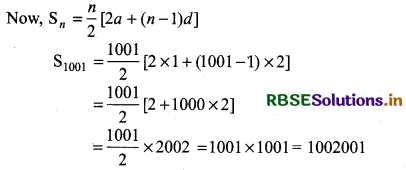
Thus, sum of odd integers from 1 to 2001 = 1002001

Question 2.
Find the sum of all natural numbers lying between 100 and 1000 which are multiples of 5.
Answer:
Between 100 and 1000 multiples of 5 are 105, 110, 115, ................, 995.
Let the sequence has n terms, then
First term a1 = 105.
Common difference d = 110 - 105 = 5
nth term, an = a1 + (n - 1)d
= 105 + (n - 1) × 5
= 105 + 5n - 5
= 5n + 100
Here, nth term is last term which is 995 in sequence.
So, 5n + 100 = 995
⇒ 5n = 995 - 100
⇒ 5n = 895
⇒ n = \(\frac{895}{5}\)
∴ n = 179
Thus, there will be 179 terms in sequence.
Sum of n terms, Sn = \(\frac{n}{2}\)(a + l)
Sum of 179 terms, S179 = \(\frac{179}{2}\) (105 + 995)
= \(\frac{179}{2}\) × 1100
= 179 × 550 = 98450
Thus, sum of natural numbers, between 10 and 1000 which are multiples of 5 = 98450
Question 3.
In an A.P., the first term is 2 and the sum of the first five terms is one-fourth of the next five terms. Show that 20th term is - 112.
Answer:
Given, first term. a1 = 2 and common difference = d
Then sum of first 5 terms = a1 + a2 + a3 + a4 + a5
Thus,sum of n terms, Sn = \(\frac{n}{2}\) [2a + (n - 1)d]
∴ Sum of first 5 terms,
S5 = \(\frac{5}{2}\)[2 × 2 + (5 - 1)d] (∵ Given, first term a =2)
⇒ S5 = \(\frac{5}{2}\) [4 + 4d]
⇒ S5 = 10 + 10d ............. (1)
Sum of next 5 terms from first 5 terms
= a6 + a7 + a8 + a9 + a10
= (a1 + 5d )+ (a1 + 6d) + (a1 + 7d) + (a1 + 8d) + (a1 + 9d)
= (2 + 5d) + (2 + 6d) + (2 + 7d) + (2 + 8d) + (2 + 9d) (∵ a1 = 2)
= 10 + 35d .................... (2)
Now, we have
Sum of first 5 terms = \(\frac{1}{4}\) × sum of next 5 terms .
Then 10 + 10d = \(\frac{1}{4}\)(10 + 35d) [From (I) and (2)]
⇒ 40 + 40d = 10 + 35d
⇒ 40d - 35d = 10 - 40
⇒ 5d = - 30
∴ d = - 6
Then 20th term = a1 + (20 - 1)d
[By formula an = a + (n - 1)d]
= 2 + 19 × (- 6) .
= 2 - 114
= - 112
Thus, 20th term = - 112
Hence Proved.

Question 4.
How many terms of A.P. - 6, - \(\frac{11}{2}\), - 5, ............., are needed to give the sum - 25?
Answer:
Let sum of n terms - 6, - \(\frac{11}{2}\), - 5 ........... is - 25.
Here, first term a1 = - 6, sum of n terms Sn = - 25
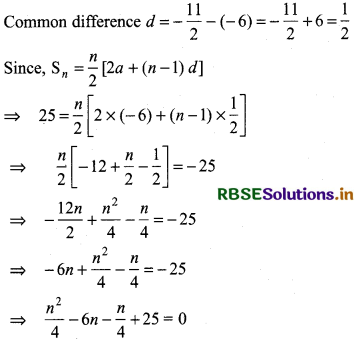
⇒ n2 - 24n - n + 100 = 0
⇒ n2 - 25n + 100 = 0
⇒ n2 - (20 + 5)n + 100 = 0
⇒ n2 - 20n - 5n + 100 = 0
⇒ n(n - 20) - 5(n - 20) = 0
⇒ (n - 20) (n - 5) = 0
Either n - 20 = 0 ⇒ n = 20
or n - 5 = 0 ⇒ n = 5 .
Thus, no. of terms will be 5 or 20.
Question 5.
In an A.P., if pth term is \(\frac{1}{q}\) and qth term is \(\frac{1}{p}\), then prove that the sum of first pq terms is \(\frac{1}{2}\) (pq + 1), where p ≠ q.
Answer:
Let first term of the A.P. is a and d be the common difference
Now, pth term = a + (p - 1)d = \(\frac{1}{q}\) ...... (1)
and qth term = a + (q - 1) d = \(\frac{1}{p}\) ......... (2)
[∵ an = a + (n - 1)d]
Subtracting equation (2) from (1),
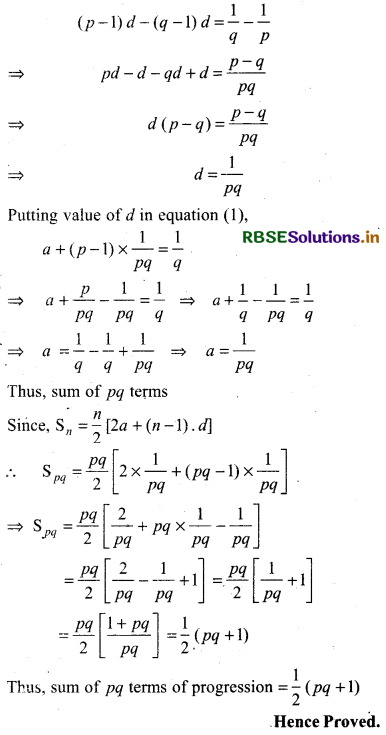

Question 6.
If the sum of a certain number of terms of the A.P. 25, 22, 19, ... is 116. Find the last term.
Answer:
First term of given progression a1 = 25
Common difference d = 22 - 25 = - 3
Let the sum of n terms of the progression be 116.
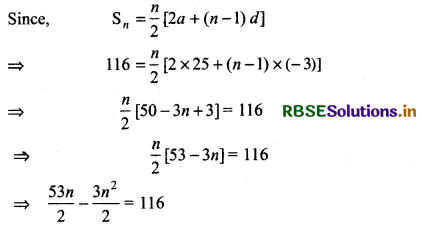
⇒ 3n2 - 53n + 116 × 2 = 0
⇒ 3n2 - 53n + 232 = 0
⇒ 3n2 - (24 + 29)n + 232 = 0
⇒ 3n2 - 24n - 29n + 232 = 0
⇒ 3n (n - 8) - 29 (n - 8) = 0
⇒ (3n - 29) (n - 8) = 0
Either 3n - 29 = 0 ⇒ n = \(\frac{29}{3}\)
⇒ n - 8 = 0 ⇒ n = 8
Since no. of terms can only be whole number not rational so n ≠ \(\frac{29}{3}\)
So, n = 8
Let last term or 8th term = a1 + (n - 1)d.
= 25 + (8 - 1) × (- 3)
= 25 - 21 = 4
Thus, last term of progression is 4.

Question 7.
Find sum of n terms of A.P. whose kth term is 5k + 1.
Answer:
Let first term of A.P. is a and d its common difference
We have, kth term of progression = 5k +1
⇒ ak = 5k + 1
Putting k = 1
First term of the progression a1 = 5 × 1 + 1 = 6
Putting k = 2
Second term of the progression a2 = 5 × 2 + 1 = 11
Putting k = 3
Third term of the progression a3 = 5 × 3 + 1 = 16
Common difference of A.P. d = a2 - a1 = a3 - a2
⇒ common difference = 11 - 6 = 16 - 11 = 5
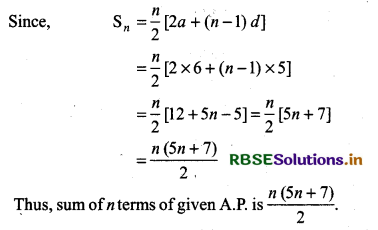
Question 8.
If the sum of n terms of an A.P. is (pn + qn2), where p and q are constants, then find the common difference.
Answer:
Let the first term of the progression be a1 and the common difference is d.
According to question,
Sum of n terms of AP.
Sn = pn + qn2 (Given)
Sum of (n - 1) terms
Sn - 1 = p(n - 1) + q(n - 1)2
Since, nth term, an = sum of n terms - sum of (n - 1) terms
⇒ an = Sn - Sn - 1
⇒ nth term, an = pn + qn2 - [p(n - 1) + q(n - 1)2]
= pn + qn2 - [pn - p + q(n2 - 2n + 1)]
= pn + qn2 - pn + p - qn2 + 2qn - q
nth term, an = 2qn + p - q
Putting n = 1, 2, 3 ..................
1st term a1 = 2q + p - q = (q + p)
2nd term a2 = 2q × 2 + p - q
a2 = 4q + p - q = (3q + p)
and 3rd term a3 = 2q × 3 + p - q
= 6q + p - q = 5q + p
........................................................
........................................................
........................................................
Common.difference d = a2 - a1
= 3q + p - (q + p)
∴ d = 3q + p - q - p = 2q
Thus, required common difference of the progression is d = 2q.

Question 9.
The sum of n terms of two A.P. are in the ratio 5n + 4 : 9n + 6 Find the ratio of their 18th terms.
Answer:
Let first term of AP. 1 is a1 and common difference is d1
Then nth term of progression
a n = a1 + (n - 1) d1 ................... (1)
Sum of n terms of this progression
Sn = \(\frac{n}{2}\)[2a1 + (n - 1)d1] ....................... (2)
Now, let first term of ASP. II is a, and common difference is d2
Then nth term of progression
An = a2 + (n - 1)d2 ........................... (3)
Sum of n terms of second A.P.
Sn = \(\frac{n}{2}\)[2a2 + (n - 1)d2] ........................ (4)
Dividing equation (2) by (4),
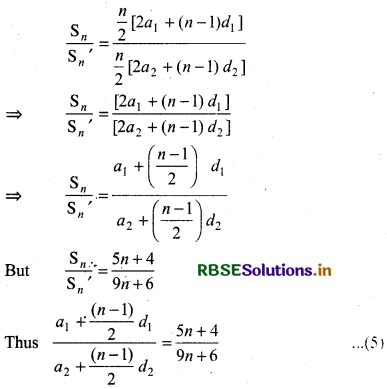
nth term of progression by equation (1)
= a1 + (n - 1)d1
So, 18th term = a1 + (18 - 1)d1
= a1 + 17d1
Similarly, 18th term of second progression
= a2 + (18 - 1) d2
= a2 + 17d2
Then ratio of 18th terms of two progressions
= \(\frac{a_1+17 d_1}{a_2+17 d_2}\) ......................... (6)
So, clearly from equation (5) ratio of 18th terms of progression can be find if coefficient of d1 and d2 are 17.
i.e., \(\frac{n-1}{2}\) = 17
⇒ n - 1 = 2 × 17
⇒ n - 1 = 34
∴ n = 34 + 1 = 35
Now, putting n = 35 in equation (5),
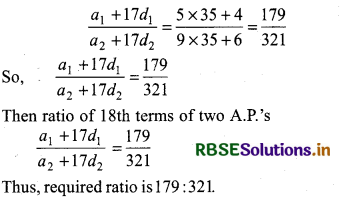

Question 10.
If the sum of first p terms of an A.P. is equal to the sum of the first q terms then find the sum of the first (p + q) terms.
Answer:
Let first term of A.P. is a1 and common difference is d
∴ Sum of first p terms
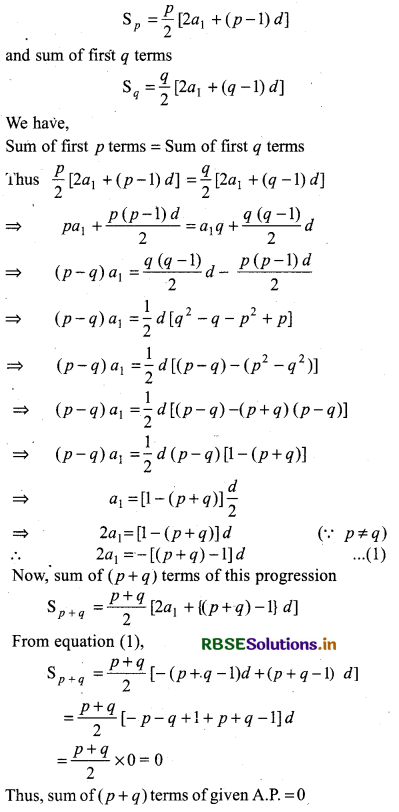

Question 11.
Sum of the first p, q and r terms of an A.P. are a, b an c respectively. Prove that
\(\frac{a}{p}\) (q - r) + \(\frac{b}{q}\) (r - p) + \(\frac{c}{r}\) (p - q) = 0
Answer:
Let the first term of given A.P. is a1 and the common difference is d, then we have
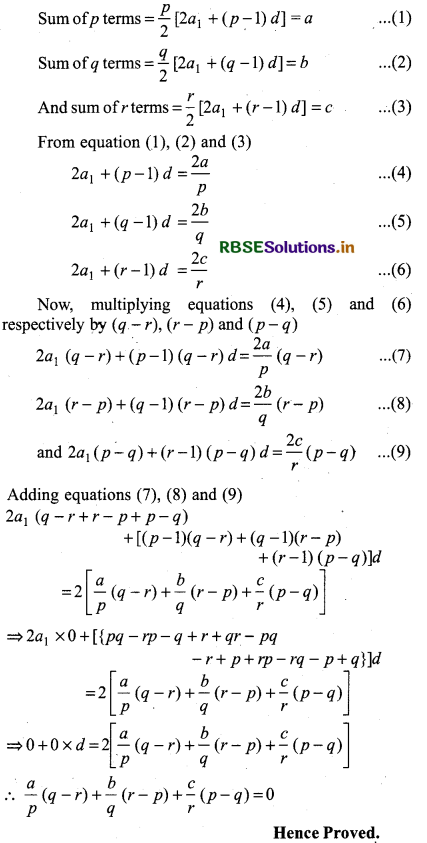

Question 12.
The ratio of the sums of m and n terms of an A.P is m2 : n2. Show that the ratio of mth and nth term is (2m - 1) : (2n - 1).
Answer:
If a be the first term of A.P. and d be the common difference.
Sum of m terms Sm = \(\frac{m}{2}\)[2a + (m - 1) d] ...................... (1)
Sum of n terms
Sn = \(\frac{n}{2}\)[2a + (n - 1) d] ............... (2)
We have,
\(\frac{\mathrm{S}_m}{\mathrm{~S}_n}=\frac{m^2}{n^2}\)
Dividing equation (1) by (2),
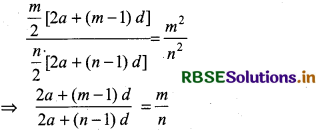
⇒ n[2a + (m - 1)d] = m[2a + (n - 1)d]
⇒ 2an + n(m - 1)d = 2am + m(n - 1)d
⇒ 2an - 2am = m(n - 1)d - n(m - 1)d
⇒ 2a(n - m) = [m(n - 1) - n(m - 1)]d
⇒ 2a(n - m) = [mn - m - nm + n]d
2a (n - m) = (n - m) d
⇒ 2a = d
⇒ d = 2a ................. (1)
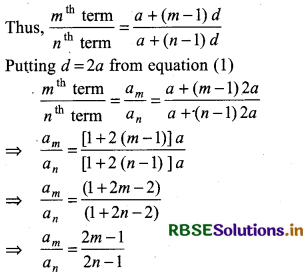
Thus, mth term : nth = (2m - 1) : (2n - 1)
Hence proved.

Question 13.
If the sum of n terms of an A.P. is 3n2 + 5n and its mth term is 164, then find the value of m.
Answer:
Sum of n terms of A.P.
Sn = 3n2 + 5n .
Sum of (n - 1) terms of AP.
Sn - 1 = 3(n - 1)2 + 5(n - 1)
then n th term of A.P. = Sn - Sn - 1
an = 3n2 + 5n - [3(n - 1)2 + 5(n - 1)]
= 3n2 + 5n - [3n2 + 3 - 6n + 5n - 5]
= 3n2 + 5n - 3n2 + n + 2
⇒ an = 6n + 2
and am = 6m + 2
Given mth term =164
6m + 2 = 164
⇒ 6m = 164 - 2 = 162
∴ m = \(\frac{162}{6}\) = 27
Thus, m = 27
Question 14.
Insert five numbers between 8 and 26 such that the resulting sequence is an A.P.
Answer:
Let five numbers between 5 and 26 are
A1, A2, A3, A4 and A5
Then A1, A2, A3, A4 and A5, 26 will be in A.P.
Now, total terms in progression = 7
7th term = 26, first term = 8 = a1
If common difference of series is d, then
7th term = a1 + (7 - 1)d [∵ a =a+(n—l)d]
⇒ 7th term = 8 + 6d = 26
⇒ 8 + 6d = 26
⇒ 6d = 26 - 8
⇒ 6d = 18
⇒ d = \(\frac{18}{6}\) = 3
Thus A1 = d + 8 = 3 + 8 = 11
A2 = A1 + d
= 11 + 3 = 14
A3 = A1 + 2d
= 11 + 2 × 3
= 11 + 6 = 17
A4 = A1 + 3d
= 11 + 3 × 3
= 11 + 9
= 20
A5 = A1 + 4d
= 11 + 3 × 4
⇒ A5 = 11 + 12 = 23
Thus, between 8 and 26 required five numbers are 11, 14, 17, 20 and 23.

Question 15.
If \(\frac{a^n+b^n}{a^{n-1}+b^{n-1}}\) is the A.M. between a and b, then find the value of n.
Answer:
We know that A.M. between a and b
= \(\frac{a+b}{2}\)
But A.M. between a and b
= \(\frac{a^n+b^n}{a^{n-1}+b^{n-1}}\) (Given)
Then two A.M's will be same
So, \(\frac{a+b}{2}=\frac{a^n+b^n}{a^{n-1}+b^{n-1}}\)
⇒ (a + b) (an - 1 + bn - 1) = 2(an + bn)
(By cross-multiplication)
⇒ a × an - 1 + abn - 1 + ban - 1 + b × bn - 1 = 2an + 2bn
an + abn - 1 + ban - 1 + bn = 2an + 2bn
⇒ abn - 1 + ban - 1 = 2an - an + 2bn - bn = an + bn
⇒ an - ban - 1 + bn - abn - 1 = 0
⇒ an - 1 (a - b) + bn - 1 (b - a) = 0
⇒ an - 1 (a - b) - bn - 1 (a - b) = 0
⇒ (a - b) [an - 1 - bn - 1] = 0
⇒ an - 1 = bn - 1 where a ≠ b

Comparing powers on both sides
n - 1 = 0
Then n = 1
Question 16.
Between I and 31, m numbers have been inserted in such a way that the resulting sequence is an A.P. and the ratio 0f 17th and (m - 1)th numbers is 5 : 9. Find the value of m.
Answer:
Let between 1 and 31, m numbers are,
1 + d, 1 + 2d, 1 + 3d, ............. 1 + md.
Then 1, 1 + d, 1 + 2d, 1 + 3d .......... 1 + md, 31 will be in A.P.
Where d is common difference of terms
Now, 7th term of sequence = 1 + 7d
and (m - 1)th number = 1 + (m - 1) d
We have,
\(\frac{1+7 d}{1+(m-1) d}=\frac{5}{9}\)
Thus 9 + 63d = 5 + 5(m - 1)d
⇒ 9 + 63d = 5 + 5md - 5d
⇒ 63d + 5d = 5 - 9 + 5 md
⇒ 68d - 5md = -4
⇒ d(68 - 5m) = - 4
⇒ d = - \(\frac{4}{68-5 m}\)
∴ d = \(\frac{4}{5 m-68}\) ............ (1)
Number of terms in sequence = (m + 2)
Now, (m + 2)th term = 31
⇒ 1 + (m + 2 - 1)d = 31
⇒ 1 + (m + 1)d = 31
⇒ (m + 1)d = 31 - 1
⇒ (m + 1)d = 30
∴ d = \(\frac{30}{(m+1)}\)
Putting value of d in equation (1)
\(\frac{30}{m+1}=\frac{4}{5 m-68}\)
⇒ 30(5m - 68) = 4(m + 1)
⇒ 150m - 2040 = 4m + 4
⇒ 150m - 4m = 2040 + 4
⇒ 146m = 2044
⇒ m = \(\frac{2044}{146}\) = 14
Thus, m = 14
Alternative Method:
If between 1 and 31, m A.M. are A1, A2, A3, A4, ......................, Am then number of terms will be (m + 2).
⇒ 1, A1, A2, A3, A4, A5, ................... Am, 31 will be in A.P.
∴ am + 2 ⇒ 31 ⇒ 1 + (m + 2 - 1)d = 31
⇒ 1 + (m + 1)d = 31
⇒ (m + 1)d = 31 - 1
⇒ (m + 1)d = 30
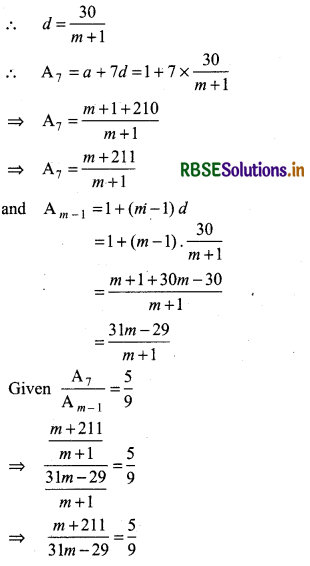
⇒ 9m + 1899 = 155m - 145
⇒ 146m = 2044
∴ m = 14

Question 17.
A man starts repaying a loan as first instalment of ₹ 100. If he increases the instalment by ₹ 5 every month, what amount he will pay in the 30th instalment?
Answer:
1st instalment of repayment, a = ₹ 100
Difference of each instalment (amount), d = ₹ 5
Now, amount 0f 30th instalment = a + (n - 1)d
= 100 + (30 - 1) × 5, where n = 30
= 100 + 29 × 5
= 100 + 145 = 245
Thus, amount of 30th instalment = ₹ 245.
Question 18.
The difference between any two consecutive interior angles of a polygon is 5°. If the smallest angle is 1200, find the number of the sides of the polygon.
Answer:
Let the number of sides in polygon be n.
Interior angles in polygon = n
Sum of interior angles of polygon = 90° × (2n - 4)
Now, smallest angles A = 120°
other angle A2 = 120° + 50° = 125°
(Difference in angles 5°)
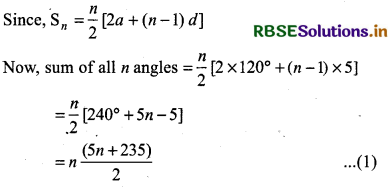
But sum of all n angles = 90° × (2n - 4) ................. (2)
Thus, \(\frac{n}{2}\)(5n + 235) = 90° (2n - 4)
From equation (1) and equation (2)
⇒ \(\frac{n}{2}\) (5n + 235) = (180n - 360)
⇒ 5n2 + 235n = 2(180n - 360)
⇒ 5n2 + 235n = 360n - 720
⇒ 5n2 + 235n - 360n + 720 = 0
⇒ 5n2 - 125n + 720 = 0
⇒ n2 - 25n + 144 = 0
⇒ n2 - (16 + 9)n + 144 = 0
⇒ n2 - 16n - 9n + 144 = 0
⇒ n(n - 16)- 9(n - 16) = 0
⇒ (n - 16)(n - 9) = 0
Either n - 16 = 0 ⇒ n = 16
or n - 9 = 0 ⇒ n = 9
∴ n = 16, n = 9
So, number of sides in polygon = 9 or 16
But 16 sides are not possible.
Since a16 = a + 15d [Given, d = 5]
= 120 + 15 × 5
= 120 + 75
= 195°
which is not possible
Thus, number of sides in polygon = 9

- RBSE Solutions for Class 11 Maths Chapter 3 त्रिकोणमितीय फलन Ex 3.1
- RBSE Solutions for Class 11 Maths Chapter 2 संबंध एवं फलन विविध प्रश्नावली
- RBSE Solutions for Class 11 Maths Chapter 2 संबंध एवं फलन Ex 2.3
- RBSE Solutions for Class 11 Maths Chapter 2 संबंध एवं फलन Ex 2.2
- RBSE Solutions for Class 11 Maths Chapter 2 संबंध एवं फलन Ex 2.1
- RBSE Solutions for Class 11 Maths Chapter 1 समुच्चय विविध प्रश्नावली
- RBSE Solutions for Class 11 Maths Chapter 1 समुच्चय Ex 1.6
- RBSE Solutions for Class 11 Maths Chapter 1 समुच्चय Ex 1.5
- RBSE Solutions for Class 11 Maths Chapter 1 समुच्चय Ex 1.4
- RBSE Solutions for Class 11 Maths Chapter 1 समुच्चय Ex 1.3
- RBSE Solutions for Class 11 Maths Chapter 1 समुच्चय Ex 1.2